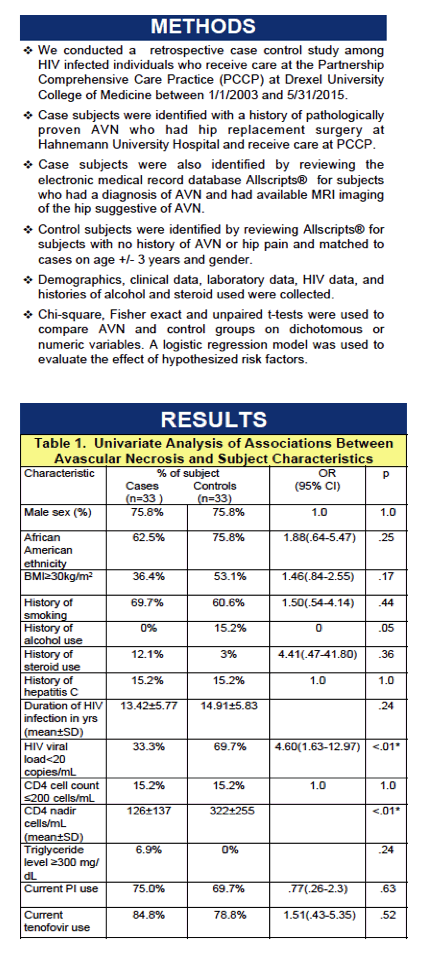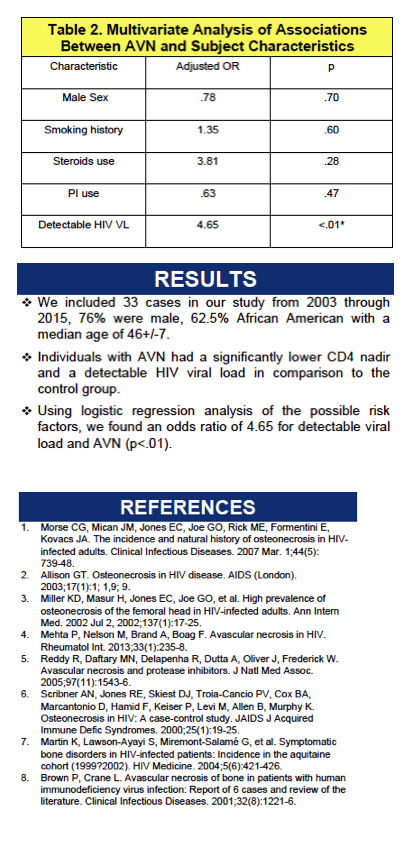 |
 |
 |
| |
Detectable Viral Load--But Not PI Use--Linked to Avascular Necrosis - Risk Factors Associated With Osteonecrosis of the Hip in an HIV-Infected
Population in the New Antiretroviral Therapy Era
|
| |
| |
IDWeek 2016, October 26-30, 2016, New Orleans
Mark Mascolini
A detectable viral load emerged as the only independent predictor of avascular necrosis (AVN) in a 66-person case-control study [1]. Unlike previous research, protease inhibitor (PI) use did not affect AVN risk in this Philadelphia analysis.
AVN is loss of blood supply to bone-forming cells and consequent bone death. Drexel University researchers and collaborators who conducted this study noted that AVN prevalence and incidence are high in HIV populations, partly because people with HIV often have AVN risk factors such as hyperlipidemia, alcohol abuse, and steroid use. Research has linked PI use to doubled odds of AVN [2]. But experts disagree on whether high AVN incidence in people with HIV reflects PI metabolic effects or longer survival with HIV.
To address these issues, the Drexel team conducted a retrospective case-control analysis. They identified cases through medical records of hip replacement surgery or hip MRI imaging. The researchers randomly selected controls who had no evidence of AVN and matched them to cases by age and gender.
Among 33 cases and 33 controls seen from 2003 through 2015, 25 in each group (76%) were men and median age stood at 46 years. The case and control groups did not differ significantly in proportions of African Americans (63% and 76%), smokers (70% and 61%), steroid users (12% and 3%), in HIV duration (13.4 and 14.9 years), or in proportions with HCV infection (15% and 15%), triglycerides above 300 mg/dL (7% and 0%), current PI use (75% and 70%), or current tenofovir use (85% and 79%). No cases and 15% of controls had an alcohol use history (P = 0.05), a significantly lower proportion of cases had a viral load below 20 copies (33% versus 70%, P < 0.01), and nadir CD4 count was significantly lower in cases than controls (126 versus 322, P< 0.01).
In multivariate logistic regression analysis, only a detectable HIV load independently predicted AVN, more than quadrupling the odds (adjusted odds ratio 4.65, P < 0.01). PI use had no impact on AVN odds in this analysis; neither did male sex, smoking history, or steroid use.
Lack of an association between PIs and AVN, the researcher suggested, may mean newer PIs have no impact on AVN risk. They proposed that "HIV infection itself may be the strongest risk factor for AVN in our study population."
References
1. Sandling M, Arif N, Taherkani S, et al. Risk factors associated with avascular necrosis in HIV-infected patients in the new antiretroviral therapy era. IDWeek 2016, October 26-30, 2016, New Orleans. Abstract 2186.
2. Permpalung N, Ungprasert P, Summachiwakij S, Leeaphorn N, Knight EL. Protease inhibitors and avascular necrosis: a systematic review and meta-analysis. Int J Antimicrob Agents. 2014;44:93-95. https://www.ncbi.nlm.nih.gov/pubmed/24726526
-------------
Risk Factors Associated With Osteonecrosis of the Hip in an HIV-Infected
Population in the New Antiretroviral Therapy Era
Marcus Sandling, MD1; Nida Arif, MD1; Sara Taherkani, MD2; Ed Gracely1; Nader Toossi, MD1;
Norman Johanson, MD1;Kimberly Dike, BS1; Zsofia Szep, MD1
1Drexel University College of Medicine, Philadelphia, PA USA;
2Howard County General Hospital Infectious Disease Associates, Columbia, MD, USA




|
| |
|
 |
 |
|
|